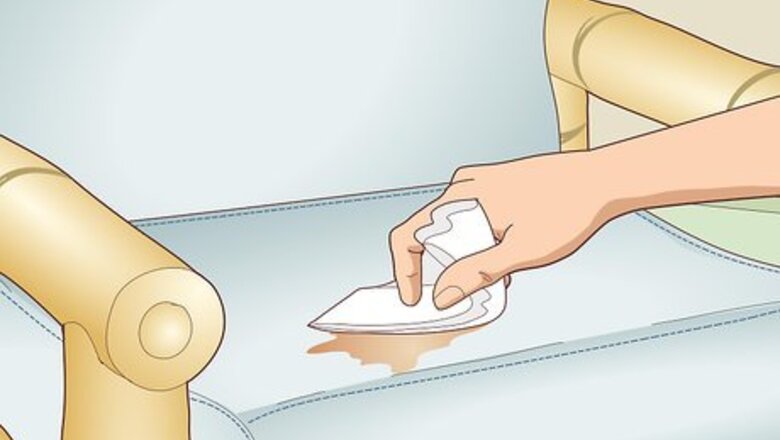
views
Spot-Treating Stains
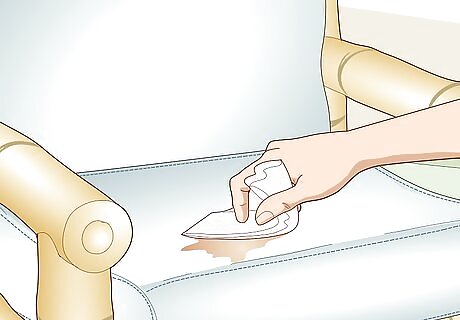
Pat the stain gently with a paper towel to absorb it. If you spilled something on your cushion, pat it dry with a paper towel. Take care to avoid rubbing the towel across the stain, since that could push it in deeper. Replace the soiled towel with a fresh one when it becomes saturated. Then, pick up the cushion and brush off any solid debris on it. The best time to tackle stains is always when you first notice them. If you’re able to get to them right away, cleaning the cushion becomes much easier. You can also vacuum cushions to remove solid debris like dirt or dust. Try using an upholstery vacuum to eliminate more debris.

Remove the cover to clean it in a washing machine. If the cover is removable, the cushion will usually have a zipper on one side. After unzipping and pulling off the cushion, check its tag. Follow the manufacturer’s instructions to ensure that your cover comes out of the wash in one piece. Generally, you can include cushion covers in with your regular laundry. Use a cold wash, low-heat setting to prevent any possible damage. If you’re unable to remove the cover, wash it by hand. You can also hand wash removable covers alongside cushions. On cushion cover tags, a W means you can spot clean with water-based cleaners. S stands for water-free dry cleaning. X is vacuum-only.

Mix a mild dish detergent in warm water to make a soapy cleaner. Try combining about ⁄2 tablespoon (7.4 mL) of dish detergent with 5 cups (1,200 mL) of water. For safety, choose a detergent without strong chemicals, scents, or anything else out of the ordinary. Your regular dish soap will be fine in most cases. Stir the mixture until it’s consistent and soapy. For example, avoid detergents made to cut through grease, since these ones can be a little too strong. If you don’t have a good dish soap available, use a mild laundry detergent instead. Another option is to use an upholstery cleaner. It works very well on cushion covers, but it can also clean the cushions themselves.
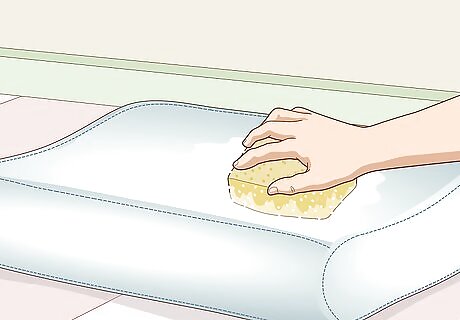
Scrub the stain gently with a clean sponge. Dip the sponge into the soapy water to dampen it. Squeeze out any excess water before using it on your cushion. Then, rub the stain in a circle. Use a light touch so you don’t end up forcing the soap or the stain deeper into the cushion. You can let the soap soak in for about 15 minutes before rinsing the pillow.
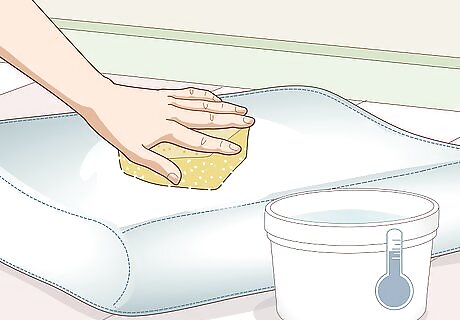
Rinse the soap off with clean, cool water. Rinse off the sponge first, then squeeze out the excess moisture. Scrub the stain in a circle again to pick up some of the soap and any remaining debris. As the sponge gets dirty, rinse it off in clean water again. Continue scrubbing the cushion until the soap is gone. You could also hose the entire cushion down with a garden hose or showerhead for a more thorough cleaning. If you do this, spend some extra time drying off excess moisture with towels before leaving the cushion to dry.
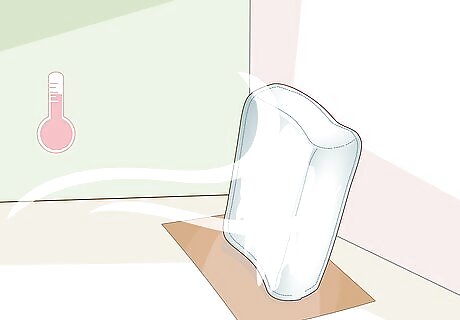
Place the cushion in a warm area with good air circulation to dry. Try placing it outdoors or near a window in your home. It doesn’t have to be in direct sunlight, but it should be out in the open. Stand the cushion up as best you can so that both sides dry out at a similar rate. A foam cushion can take 15 minutes or more to dry, but check on it occasionally until it feels completely dry to the touch. Use a hair dryer to dry out the cushion at a faster rate. Hold it at least 6 in (15 cm) away and move it around steadily so it doesn’t damage the cushion.

Blot the stained area with vinegar or peroxide if soap doesn’t work. Use more soap and water for a safe way to clean it. If you’re looking for something stronger, try dampening a clean rag in vinegar or even hydrogen peroxide. Blot any stains with the rag, then wash them again with cold water. Scrub them with a scrub brush or an old toothbrush as well. For example, you could mix 1 cup (240 mL) of hydrogen peroxide, 1 teaspoon (4.9 mL) of white vinegar, and 2 tablespoons (28.80 g) of baking soda into a paste. Leave it on the cushion overnight, then wash it off the next day. You may need to clean the cushion several times to remove really tough or old stains and odors.
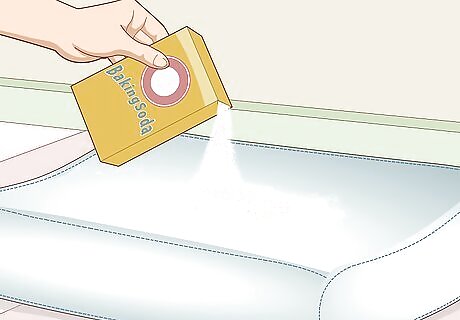
Sprinkle baking soda onto the cushion to eliminate odors. Cover stains completely under a layer of baking soda. Leave the cushion to sit out in an area with good air circulation for at least 2 or 3 hours. Then, come back and vacuum up the baking soda. If you’re having a hard time vacuuming up the last bits of baking soda, shake the cushion or hit it several times to knock the rest off. Baking soda is great for sucking up unpleasant smells, but it can also help absorb tough stains. If you notice strong odors coming from a cushion even after cleaning, wash it and apply baking soda several times.
Deep-Cleaning Cushions
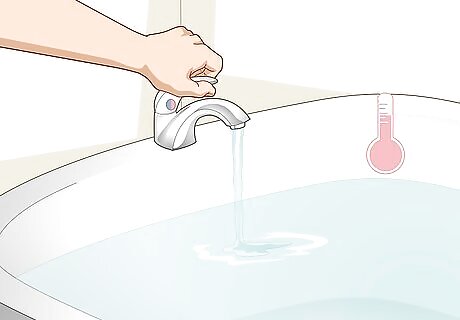
Fill a bathtub with enough warm water to submerge the cushion. Make sure you’re using a clean bathtub so your cushion doesn’t absorb more debris. If you’re able to get the cushion outdoors, you could also clean it there using a hose. Another option is to set up a small wading pool so you don’t end up with as much of a mess in your home or yard. Cleaning cushions outdoors is great for avoiding messes in your home, but you can get the foam dirtier if you aren’t careful with it.
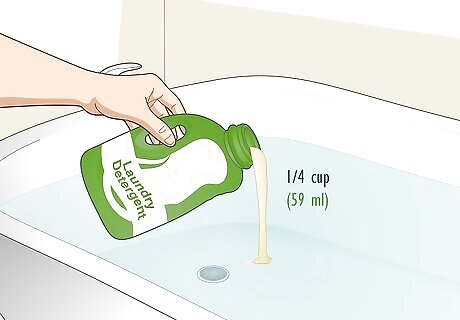
Add about ⁄4 cup (59 mL) of laundry detergent to the water. Select a mild detergent meant to be used on delicates. This type of detergent won’t have any dyes or fragrances in it that could affect the foam. Spread it around the water as much as you can. Then, reach in and ln and lightly swirl the water around to make it soapy. Mild laundry detergents are sometimes labeled as free and clear. As long as it works on delicate clothing, it will most likely be fine on cushions, too.
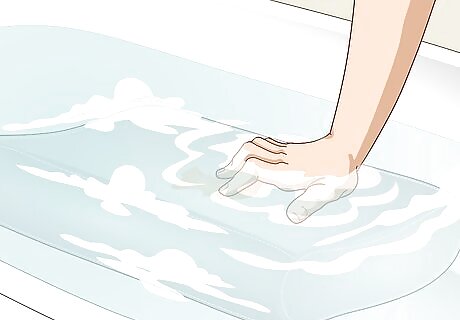
Press down on the cushion by hand to force water into it. Lower the cushion into the water, submerging it. Push down on the cushion as hard as you can. Start on one end and slowly work your way to the other end to ensure you don’t miss any spots. Pressing down on the cushion causes it to suction up water, rinsing it out. Deal with stubborn stains by scrubbing them out with a scrub brush. If you don’t mind getting your feet wet, you could step on top of the cushion. Press it down with your feet like you’re crushing a bunch of grapes. If you’re unable to compress a cushion or afraid of damaging it this way, apply the soapy water with a sponge, then let the cushion soak for 15 minutes.
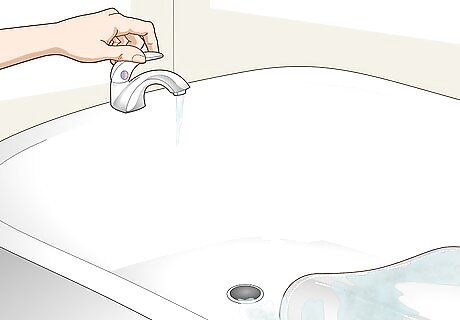
Drain and refill the tub if it starts to look grimy. This will depend on how dirty the cushion is. If the water looks a little murky, you’re better off taking the time to freshen up. Leave the cushion in the tub while you drain the water. Then, refill it with warm water mixed with more soap. Draining out the dirty water prevents it from lingering on and staining your cushion. If you’re cleaning multiple cushions, you most likely will need to change out the water at least once.

Refill the tub with clean water to rinse out the soap. Add enough warm water to submerge the cushion again. Then, squeeze it all over. Remove as much of the remaining debris as you can. If you have a detachable showerhead, you can use it to spray down the outer part of the cushion to finish cleaning it more quickly. If you’re outside, use a hose to clear soap from the cushion. Squeeze it to press out any remaining soap or debris inside of it.
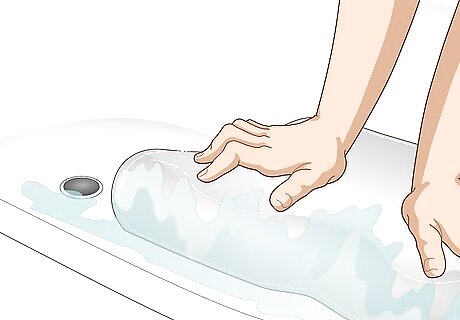
Drain the tub to squeeze excess moisture out of the cushion. Once the water has drained, compress the cushion again by hand. Start at the end furthest from the drain. Push on it to get out as much moisture as you can. Work toward the end closest to the drain while squeezing each section. Take your time. Make sure you squeeze the cushion all over. When you are unable to get more water out of it, you can let it dry on its own. Removing water now helps the cushion to dry faster. It also means you won’t have to try carrying a heavy, waterlogged cushion to a good drying spot.
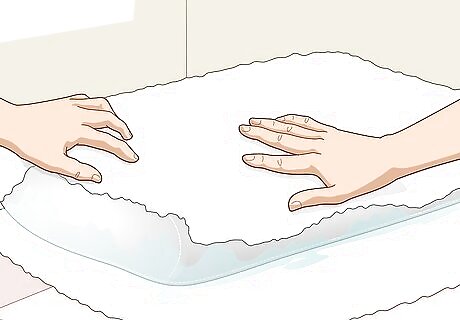
Wrap the cushion in bath towels to blot out leftover moisture. Get a bunch of clean towels, placing some of them underneath the cushion. Wrap the rest over its top. Give it a good squeeze one more time to force out any remaining moisture you couldn’t get earlier. Make sure you cover and squeeze the entire cushion. Dirty towels will only get cushions dirty again. If your towels become soaked, swap them out for fresh ones. Try to remove as much moisture by hand as you can. It will enable cushions to dry out at the fastest possible rate, making them less likely to attract mildew.
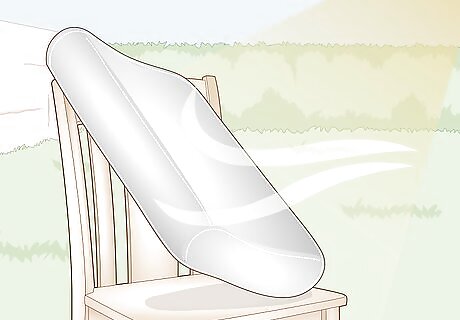
Move the cushion to a warm area with good air circulation to dry. Take it to a sunny spot outdoors, for instance, or leave it in your bathtub. However, stand it up on one end so the bottom is able to dry. Wait until it feels completely dry to the touch. It can take 30 minutes or more. Afterward, test it by pressing a paper towel down hard against it to see if any moisture comes out. If you’re trying to dry your cushion off indoors, open nearby doors and windows to let more air into the room. Fans can also help. If you’re trying to speed things up, use a hair dryer. The cushion has to be completely dry to prevent mildew growth. Don’t leave the cushion in a cool, dark place, since it won’t dry out fast enough there.













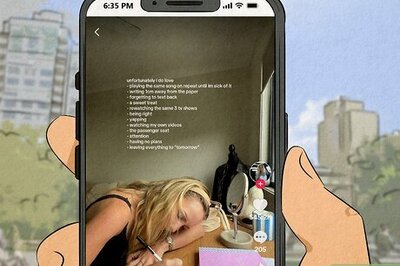



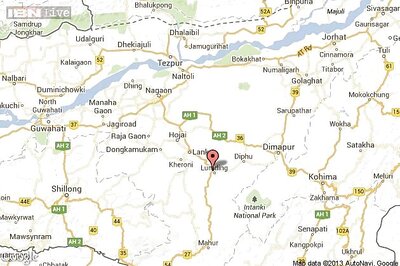
Comments
0 comment